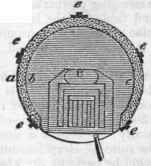Kilns For Drying Corn
Description
This section is from the book "The Engineer's And Mechanic's Encyclopaedia", by Luke Hebert. Also available from Amazon: Engineer's And Mechanic's Encyclopaedia.
Kilns For Drying Corn
If air and moisture be a refully excluded from grain, it may be kept uninjured for an indefinite length of time. This is proved by an extraordinary experiment made with some Indian cum found in the graves of the ancient Peruvians, buried more than 300 years ago. Some of this corn being sown, it vegetated and came to maturity: we believe a similar fact is recorded respecting some grain found in the ruins of Herculaneum. But to preserve corn, even for a short period, it should be perfectly dry when housed, and carefully protected from dampness; but it not unfrequently happens, during a wet harvest season, that the corn is necessarily carried from the field in a damp state; and as few farmers have the means of properly and speedily drying it, large quantities are irrecoverably spoiled after all the labour and cost of production. The method of drying on the perforated floor of a kiln, (which is usually resorted to where it can be obtained,) is a very tedious, defective, and expensive mode, and is attended with great labour, owing to the grain requiring to be continually turned over and spread by a workman, whose utmost care is insufficient to cause every part to receive an equal degree of heat; it therefore becomes a matter of considerable importance to devise a simple, efficacious, and economical method of drying grain under these circumstances, and we think Mr. Jones's apparatus for this purpose (shown in the engraving on the next page) is well adapted to the end proposed.
Fig. 1 is a vertical section of the apparatus, which is formed of two iron cylinders a b, placed one within the other, each being closed at the upper and lower end by two concentric cones C D. The annular space between the cylinders, as also between the cones, is an inch and a quarter in width, for the reception of the grain, to be dried by its passing through the machine; both the internal and external bodies are perforated throughout with about 2300 holes to the square foot. The kiln is supported on five cast-iron columns or legs, three of which are shown in the section as at E, these are attached to a strong iron ring which surrounds the base of the cylinder. From the heads of these columns descend, along the sides of the cone, five long bolts, as at G, which are passed through the same number of legs in the cast-iron ring surrounding the neck of the lower cone: from this ring proceed five stays, as at I, which are fastened to the middle of the columns by a nut on each side. The body is sustained, both externally and internally, by iron hoops, as at K, and the distance between the cylinders is preserved by a number of short stays.
In the front of the kiln a passage is cut out, as at O, in which is fixed the fire place, through which are passages for the heated air to pass into the cylinder. These passages, as well as the flues, which proceed circuitously from the fire to the chimney, are best shown in the horizontal section, Fig. 2; and in the vertical section of the detached fire-place, Fig. 3, Q is the fire-hole, S the ash-hole, T the fire-bars, and U the chimney, which passes up nearly in the middle of the kiln. The wheat is admitted into the kiln from above through a hopper and through the tube W, and falling upon the apex of the cone is distributed equally on all sides between the cylinders, the little asperities in which, not only slightly retard the descent of the grain, but likewise impart to the particles, a constant, slow, rolling motion, whereby every individual grain is exposed to the same degree of temperature; the grain from thence converges into the lower cone, and ultimately escapes through the spout at bottom into sacks or on to the ground as may be required. The passage of the grain through the machine may be either accelerated or retarded, according to its peculiar condition, by enlarging or contracting the aperture through which it is discharged.
The moisture is carried off by evaporation through the perforations of the plates with great rapidity. The kilns may of course be made of any dimensions; one of six feet internal diameter, and twelve feet in length, between the apexes of the upper and lower cones, has been said to be capable of perfectly drying more than 100 quarters of wheat in 24 hours.
Fig. 1.

Fig. 2.

Fig. 3.

The following contrivance for drying grain has been noticed in several trench papers, and announced as having been successfully adopted in one cf the departments; the plan, however, originated with a correspondent in the Register of Arts. The apparatus consists of a long spiral tube a a like a distiller's worm, reaching from the basement to the upper floor and through the roof of the granary, which forms a passage for the heated air from a close stove below. Externally round this tube is placed another tube b b, winding like the interior one in a spiral direction, and at about an inch and a half from it; this external tube receives the corn from above through a hopper c, and it is punched throughout with numerous small holes, through which the vapour escapes, as it is formed by the damp corn coming in contact with the inclosed heated chimney; the corn in consequence becomes thoroughly dried before being discharged at the bottom, and that without the intervention of any manual labour.
Continue to:


